Pages 14 & 15 next page
This article and all associated photographs is the property of Dr. Jo Thompson & may not be reproduced in whole or in part without her express written consent.
The Lukuru Program - Part 2
The Fabric of Time
by Dr. Jo Thompson
The fabric of time is a vibrant tapestry woven from the threads of moments gone-by intermingled with present day.
As Basenji fanciers, we can wrap ourselves in the folds of this colorful and complicated framework by bringing the past alongside the present. But, what will that relationship reveal? In the past year there has been vigorous dialogue around the sport of conformation dog show competition concerning how some purebred breeds have been developed away from their original type as a result of breeding patterns in pursuit of the current winning fashion. For comparison, over the course of more than 70 years of Basenji breed progress where are we today?
The original breed Standard for the Basenji was based on the type characteristics of the Basenjis from the first successful importations (1936 and 1937). The original breed description, which is still the mainstay of the Standard, was written with the dogs in front of them and based on personal knowledge of the dogs phenotype and function in their native homeland, thus maintaining the native type. Mrs. Olivia Burn was the original breed pioneer and one of the principal authors of the breed Standard. She was the first successful importer of Basenjis when she started a breeding program from seven native dogs brought from an area around Kwenge (Kikwit) in the Congo, all carrying the "of Blean" affix. It is the Blean dogs type that defined the breed Standard.
In August 2008 the American Kennel Club announced that it opened, for a limited time, the Basenji studbook in order to offer an opportunity to import dogs from their native land. In anticipation of this momentous act, four dogs were imported from the Congo under the moniker "Lukuru" in 2007. 70 years ago the Blean dogs came from an area approximately 340 kilometers (~210 miles) from what is today central Lukuru (as the crow flies [i]). In the Lukuru, the dogs continue to fulfill the same function for which they originated long before written time.
Please permit me to introduce you to the four Lukuru imports. Each picture shows the individual in the Congo as a puppy (image on left) and today as an adult (image on right).
1) Lukuru na Liboso Mopaya is a red and white bitch born January 2007 in the village of Itunga and bred by the NDengese people.
(photo 1)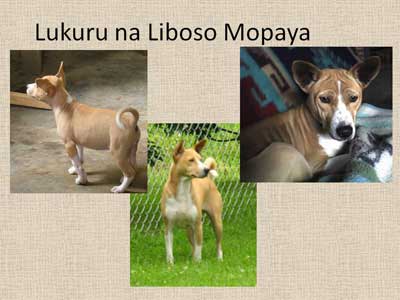
2) Lukuru Amisi is a red and white dog born May 2007 in the village of Luapa and bred by the Iyaelima people.
(photo 2)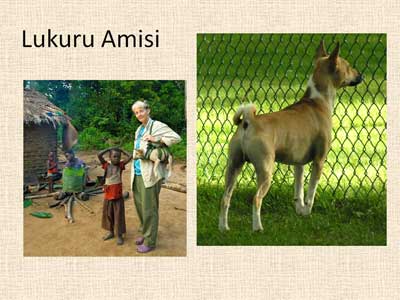
3) Lukuru MPale is a red and white bitch born June 2007 in the village of Yasa and bred by the Ikolombe people.
(photo 3)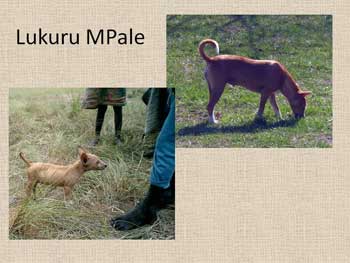
4) Lukuru Lema is a red and white bitch born June 2007 in the village of Yasa and bred by the Ikolombe people.
(photo 4)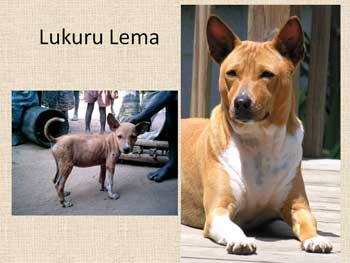
Lema and MPale are the only two puppies from their litter. Mopaya is from a village about 45 km (~30 miles) north of where Lema and MPale were born; their birth villages are separated by an impassable river barrier. Amisi was born an additional 320 km (~200 miles) north of the birth place of Mopaya, in the very center of the vast ancient equatorial forest. MPale and Lema are considered to represent a single founder event.
Old photos of purebred dogs can illustrate how much breeds have changed or remained uniform through the past century and can serve to validate consistency of type through generations (the hallmark of a breed). Thus, by locating historic images we are able to put the past beside the present. Typical of zoological gardens towards the close of the 19th century, institutions frequently contained collections of domestic dogs exhibited by breed. For example, the Berlin Zoological Gardens (Germany), under the leadership of Professor Dr. Lutz Heck, possessed a collection of "interesting" breeds from the perspective of naturalists and fanciers. Included in the exhibition of rare breeds were the "Congo Native Dogs" of which two were imported from the Congo in 1903 and the rest were bred in the Gardens. It was written about the Congo dogs at the Berlin Zoo that "though little, if any, care is bestowed upon the breeding of these native dogs, they are decidedly breedy-looking, and very handsome." Coincidentally, the brothers Lutz and Heinz Heck (Directors of the Berlin and Munich Zoos respectively) played an instrumental role and were historic figures in the history of the bonobo [ii] in captivity. In his dealings with traders bringing animals from the Congo, Heinz is credited with coming up with the name "bonobo" for specimens shipped from their equatorial forest home. It is not a coincidence that the original range of bonobos overlays a portion of the provenance of the original Basenjis.
(photo 5)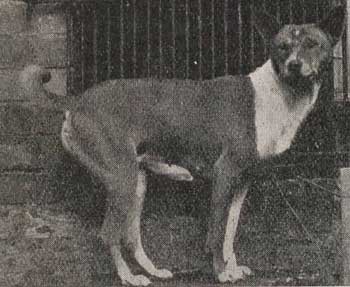
Once Basenjis were successfully maintained in England and a breeding program developed out of the Blean native import stock, images of type began to be recorded. From these we can reflect on the history of the breed. The Lukuru imports reached American soil on the 70th year anniversary of the first live Basenjis to come to the USA. In 1937 Mr. B. Hamilton Rogers traveled to England to purchase breeding stock Basenjis for his company, Dogs, Inc. under Mrs. Olga Rogers (no relation), to supply "barkless" dogs for the American masses. At that time he was able to import to the USA a stud dog, Bakuma of Blean (later known as Phemister's Bois) and two bitches which were to be the foundation of the first Basenji breeding program in America. Bakuma of Blean was one of the seven original Basenjis brought from the Congo by Olivia Burn, but was purchased while in quarantine and shipped directly to the USA. Basashi of Blean (F) born 28 Jan 1937 was first generation offspring from Bongo of Blean (M) and Bereke of Blean (F); two of the original Basenjis imported from Congo. Basashi was eight months old to the day upon her arrival in the USA.
(photo 6)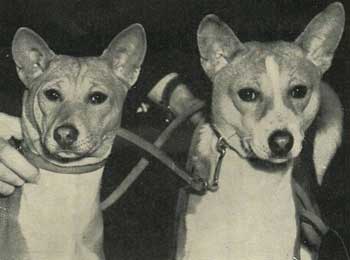
In the first years of Mrs. Burn's efforts to establish the breed, she was able to produce many litters out of her foundation breeding stock in England. Her breeding stock was established from Bongo (M), Bashele (M), Bungwa (M), Bokoto (F), Bereke (F), and Basanga (F), all "of Blean". It was these early efforts that provided stock for officially registering the Basenji as a recognized breed outside their native homeland where no registry exists. Additionally, she was able to provide foundation stock for other breeding programs to preserve the breed.
(photo 7) 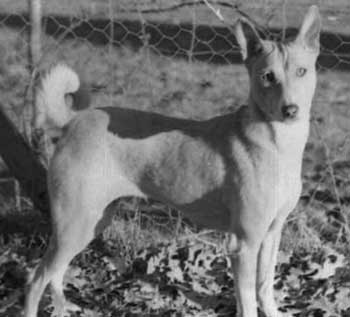
(photo 8)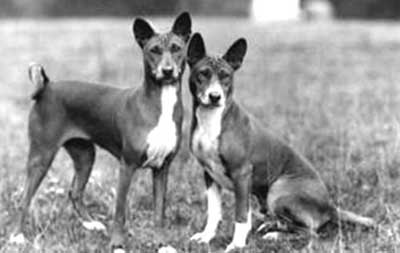
Some European zoological gardens continued the antiquated practice of housing and exhibiting unique breeds. Specifically, Belgium's colonial relationship with the Congo promoted intense interest in the unique fauna/wildlife of that country. On 31 August 1950 the Antwerp Zoo, Belgium received a breeding pair of native imported Basenjis from the Congo. They were bred and produced two litters; the second one did not survive beyond a few months of age. The imported native pair included Djaga (M), who was presumed to be 3 years old at importation and was described as shorthaired, good gait, both ears deformed due to ear infection from external parasites. The other half of the pair was Deanne (F), who was presumed to be 1 1⁄2 years old at importation and was described as red and white. Their first litter was born 11 January 1951: 4 male pups Epi - black and tan and white; Eolo - black and tan and white; Eranga - red and white who died 13 August 1951; and Ekuta - red and white.
(photo 9)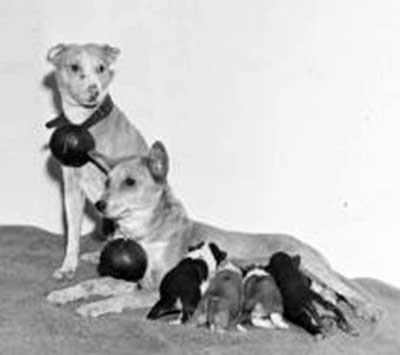
So, what can our glimpse into the relationship between past and present breed type demonstrate about where our breed is today? I believe it illustrates that native type, as revealed by the original imports, has remained fixed and consistent through time to native stock today in localities where outside breeds have not introgressed. This illustrates the proper recognition of Basenji breed heritage and identity in recent imports from a geographically proximate provenance. The Oxford English Dictionary says a breed is "a line of descendants perpetuating particular hereditary qualities," individuals who have similar heritage and appearance.
When the Basenji Club of America members agreed to include approved native stock into their breed studbook they, through extension of that act, took a bold step to better the breed by returning to its true origins. The Lukuru native stock can reconstitute unique genes from the founding source to the modern gene pool while maintaining authenticity of type. Trueness to phenotype is the measure of matching the breed standard as it was written from the original imports. Regional uniformity, consistency and permanence of phenotype in the collection locality are crucial measures that demonstrate a stable history remaining distinct as regards to ancestry and maintenance of breed type.
The final installment of the Lukuru program trilogy will introduce the reader to the breeding program management team and bring you up-to-date on Mopaya, Amisi, MPale, and Lema. Stay tuned.
Photo 1 : Lukuru na Liboso Mopaya
Photo 2 : Lukuru Amisi
Photo 3 : Lukuru MPale
Photo 4 : Lukuru Lema
Photo 5 : 1903 photo from Berlin Zoo of "Congo Native Dog" (F) Photo 6 : 1937 photo of Bakuma of Blean (M) on right, later known as Phemister's Bois and the Basashi of Blean (F) on left, arriving in the United States.
Photo 7 : 1938 photo of Senji of the Congo (F) bred by Olivia Burn; first generation pedigree from the original founders Bashele of Blean, Bongo of Blean and Bereke of Blean.
Photo 8 : ~1940 photo of Ousefleet Tango (F on left, whelped 28 November 1938) is second generation pedigree from the original founders Bashele of Blean, Bongo of Blean and Bereke of Blean and Ousefleet Ombombo (M on right, whelped 4 January 1939) is first generation pedigree from the original founder Bungwa of Blean (M).
Photo 9 : 1951 photo from the Antwerp Zoo: a breeding pair of native imported Basenjis from the Congo with their first litter.
[i] "As the crow flies" is an idiom referencing the shortest route between two points.
[ii] The bonobo is one of the rarest species of Great Ape and is the focus of my field work in the Democratic Republic of Congo (see Part 1 of trilogy). The wild bonobo global population is entirely endemic (found only in a certain area) to the DRCongo and occupies a very restricted geographic range within a portion of the country.